The Moon and Tides
Earth’s only natural satellite provides one of the most dramatic sights in the nighttime sky. The Moon is so large and so close to us that some of its surface features are readily visible to the naked eye. Even without a telescope, you can easily see dark gray and light gray areas that cover vast expanses of the Moon (Figure 6-14). People have dreamed of visiting our nearest neighbor in space for millennia. One of the first movies ever made (1902) was A Trip to the Moon, based on Jules Verne’s book From the Earth to the Moon. The wonder of actually sending people there for the first time was one of the few things that has ever caused humanity to stop its quarreling long enough to participate, even vicariously, in a great adventure. To date, 12 people have walked on the Moon. Our exploration of it begins with a study of its surface.

171
6-5 The Moon’s surface is covered with craters, plains, and mountains
Margin Question 6-5
Question
Which of the three named craters in Figure 6-15a is the youngest?
Perhaps the most familiar and characteristic features on the Moon are its craters (Figure 6-15a). As discussed in Chapter 5 on the formation of the solar system, all lunar craters that we have examined are the result of bombardment by meteoritic material (rather than volcanic activity). Nearly all of these craters are circular, indicating that they were not merely gouged out by moderate-speed rocks, which would create lopsided craters if they struck the surface at an angle. Instead, the high-speed (upward of 180,000 km/h or 112,000 mi/h) collisions with the Moon’s surface vaporized the rapidly moving debris coming in at any angle, often with the power of a large nuclear bomb. The resulting explosions of hot gas and rubble produced the round-rimmed craters that we observe today (Figures 6-15b, c, and d).
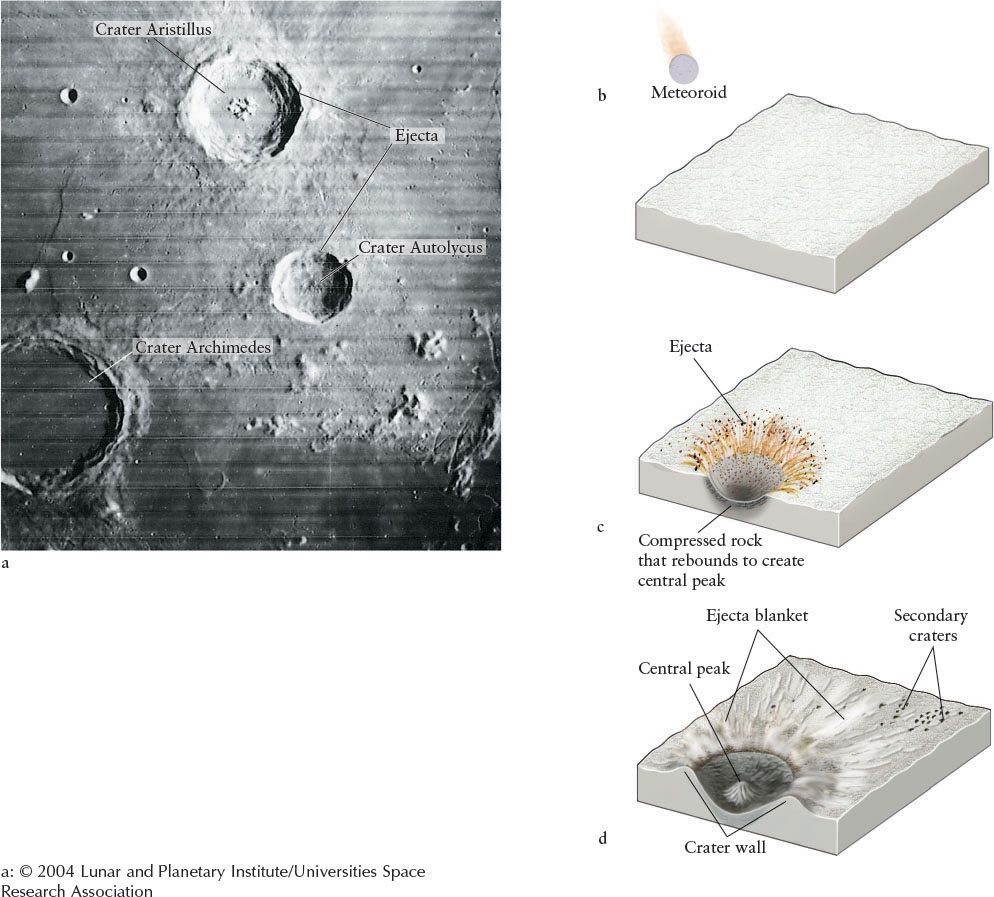
Meteoritic impact causes material from the crater site to be ejected onto the surrounding surface. This pulverized rock is called an ejecta blanket. You can see some of the more recent ejecta blankets, which are lighter-colored than the older ones, in Figures 6-14 and 6-15a. If the impact is relatively slow and at a shallow angle (as contrasted with head-on), then the ejecta blanket can have a missing region. Laboratory experiments reveal that the impacting body comes from the direction without ejecta (Figure 6-16).
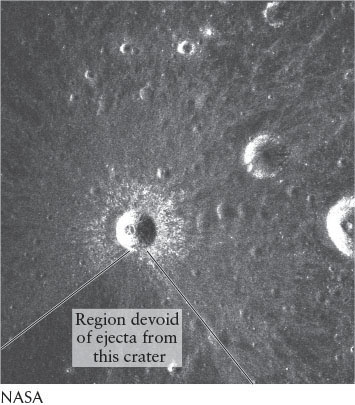
Ejecta blankets darken with time as their surfaces roughen from impacts by the solar wind and other particles from space. Therefore, the lightness of a crater’s ejecta is one clue astronomers use to determine how long ago a crater formed.
172
Craters larger than about 20 km in diameter often form central peaks (see Figure 6-15c). These features occur because the impact compresses the crater floor so much that afterward the crater rebounds and pushes the center upward. As the central peak goes up, the crater walls collapse and form terraces.
Through an Earth-based telescope, some 30,000 craters, with diameters ranging from 1 km to more than 100 km, are visible. Following a tradition established in the seventeenth century, the most prominent craters are named after astronomers, physicists, mathematicians, and philosophers, such as Kepler, Copernicus, Pythagoras, Plato, and Aristotle. Close-up photographs from lunar orbit reveal millions of craters too small to be seen with Earth-based telescopes. Indeed, extreme close-up photos of the Moon’s surface reveal countless microscopic craters (Figure 6-17).
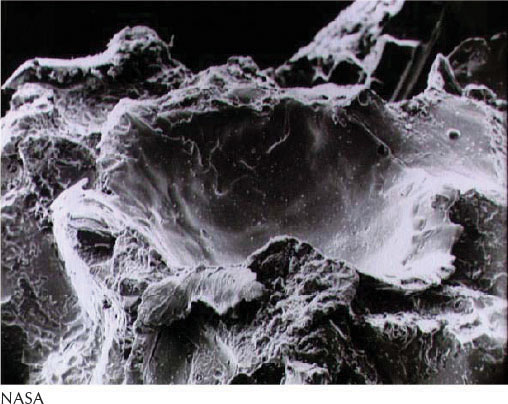
Earth, by comparison, has only 178 known craters caused by impacts. Many craters on Earth have been pulled inside our planet by plate tectonic motion and obliterated. Many other craters of a few kilometers in diameter and smaller have been worn away (eroded) by weathering effects of wind and water. Earth’s atmosphere vaporized countless space rocks that would otherwise have created small craters here. Moreover, those that do hit are slowed down by the atmosphere so that they produce smaller craters than they otherwise would have. We will discuss Earth’s craters further in Chapter 9.
Besides its craters, the most obvious characteristic of the Moon visible from Earth is that its surface is various shades of gray (see Figure 6-14). Most prominent are the large, dark gray plains called maria (pronounced mar′-ee-uh). The singular form of this term, mare (pronounced mar-ay), means “sea” in Latin and was introduced in the seventeenth century when observers using early telescopes thought that these features were large bodies of water. We know now that no liquid water exists on our satellite. Nevertheless, we retain these poetic, fanciful names, including Mare Tranquillitatis (Sea of Tranquility), Mare Nubium (Sea of Clouds), Mare Nectaris (Sea of Nectar), and Mare Serenitatis (Sea of Serenity). As introduced in Chapter 5 and as we will discuss further shortly, maria are basins on the Moon that were filled in with lava during the Late Heavy Bombardment (see Section 5-7). One of the largest of the maria is Mare Imbrium (Sea of Showers). This mare is roughly circular and measures 1100 km (700 mi) in diameter (Figure 6-18).
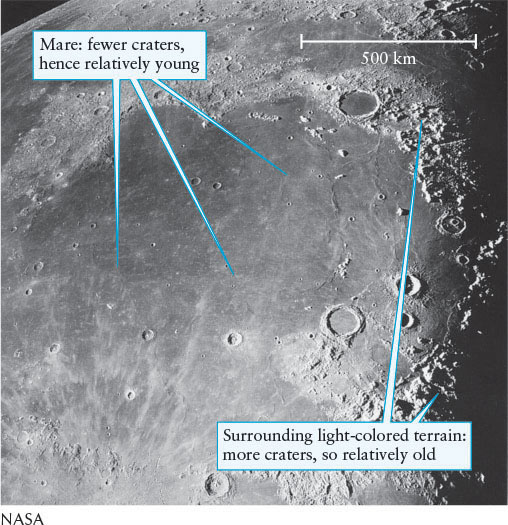
173
Although the maria seem quite smooth in telescopic views from Earth, close-up photographs from lunar orbit and from the surface reveal that they contain small craters and occasional wandering channels, called rilles (Figure 6-19). Rilles are believed to form for at least two reasons: When meandering underground tubes of molten rock stop flowing and the magma in them either drains out or solidifies in place and thereby condenses, the ceilings of the tubes are no longer supported, and they collapse. Also, if lava rivers flowed on the Moon’s surface and then stopped running, they would have drained away, leaving beds that we see as maria.

174
Support for the existence of lava tubes on the young Moon came in 2009, when a Japanese lunar orbiter, SELENE, observed a nearly circular hole about 65 m in diameter and 85 m deep on the Moon’s surface. This width-to-height ratio is inconsistent with it being an impact crater. Rather, it is believed to be the opening of one such tube (Figure 6-19c). A similar feature, discovered in 2010, is a natural bridge between two parts of the same collapsed opening. The surface apparently solidified before the liquid rock underneath drained away. As the gap widened below the solid surface, some but not all of it collapsed, leaving the bridge (Figure 6-19d). It is interesting to note that emptied lava tubes are also found on Earth in Hawaii, for example.
As we will discuss further in Section 6-8, the same side of the Moon always faces Earth. One of the surprises stemming from the earliest lunar exploration is that the far side is much more heavily cratered than the near side. A few tiny maria, including Mare Moscoviense, Mare Ingenii, and Mare Australe, plus one moderatesized mare, Orientale, grace the Moon’s far side, the side we never see from Earth (Figure 6-20). Unlike the maria on our side, those on the far side are only partially filled with lava. Otherwise, craters and mountains cover the entire far side of the Moon.
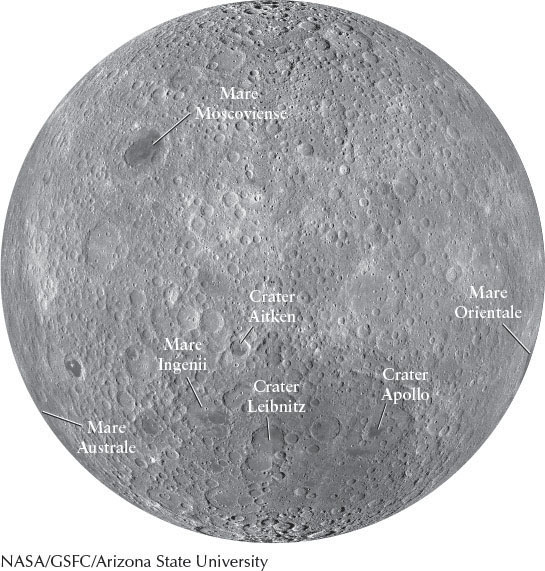
 The Far Side of the Moon Unlike the side of the Moon facing the Earth, the lunar far side has only a few, small maria. It is almost entirely covered with highlands.
The Far Side of the Moon Unlike the side of the Moon facing the Earth, the lunar far side has only a few, small maria. It is almost entirely covered with highlands.
Detailed measurements by astronauts in lunar orbit demonstrated that the maria on the Moon’s Earth-facing side are 2 to 5 km below the average lunar elevation on that side, whereas the ones on the far side are 4 to 5 km above the average lunar elevation. The difference in heights of the maria on the two sides of the Moon apparently stems from the way they were formed. Those maria on the near side were created by flows of lava that filled low-lying basins (enormous craters) surrounded by highlands. These mountains were pushed up by the large impacts that formed these craters during the Late Heavy Bombardment. The small maria on the far side were more likely lava flows that pushed up and out into craters relatively high in the mountains, rather than into low-lying basins.
The relative ease with which maria on the near side of the Moon formed, compared to the far side, is explained by the observation that the crust on the near side is thinner than on the far side. The impacts that created what became the maria formed craters that thinned the near side crust even further, making eventual seepage of lava easier on our side.
The flat, low-lying, dark gray maria cover only 17% of the entire lunar surface. The remaining 83% is composed of light gray, heavily cratered mountainous regions, called highlands (see Figure 6-14). One mountain range created by an impact can be seen around the edge of Mare Imbrium (see Figure 6-18). Although they take their names from famous terrestrial ranges, such as the Alps, the Apennines, and the Carpathians, the lunar mountains were not formed through plate tectonics, as were mountains on Earth.
6-6 Visits to the Moon yielded invaluable information about its history
 Reaching the Moon became national obsessions for the United States and the former Soviet Union in the early 1960s. A series of successful space missions by the Soviet Union spurred President John F. Kennedy’s goal of landing a person on the Moon by the end of that decade.
Reaching the Moon became national obsessions for the United States and the former Soviet Union in the early 1960s. A series of successful space missions by the Soviet Union spurred President John F. Kennedy’s goal of landing a person on the Moon by the end of that decade.
175
 The first of six manned lunar landings, Apollo 11, set down on Mare Tranquillitatis on July 20, 1969. Astronaut Neil Armstrong (1930–2012) was the first human to set foot on the Moon. In the same year, Apollo 12 also landed in a mare. Human voyages into space encountered a setback when Apollo 13 experienced a nearly fatal explosion en route to the Moon. Fortunately, a heroic effort by the astronauts and ground personnel brought it safely home. Apollo 14 through Apollo 17 took on progressively more challenging lunar terrain. The period of human visitation to our Moon lasted less than 4 years, culminating (and ending) in 1972, when Apollo 17 landed amid mountains just east of Mare Serenitatis (Figure 6-21).
The first of six manned lunar landings, Apollo 11, set down on Mare Tranquillitatis on July 20, 1969. Astronaut Neil Armstrong (1930–2012) was the first human to set foot on the Moon. In the same year, Apollo 12 also landed in a mare. Human voyages into space encountered a setback when Apollo 13 experienced a nearly fatal explosion en route to the Moon. Fortunately, a heroic effort by the astronauts and ground personnel brought it safely home. Apollo 14 through Apollo 17 took on progressively more challenging lunar terrain. The period of human visitation to our Moon lasted less than 4 years, culminating (and ending) in 1972, when Apollo 17 landed amid mountains just east of Mare Serenitatis (Figure 6-21).
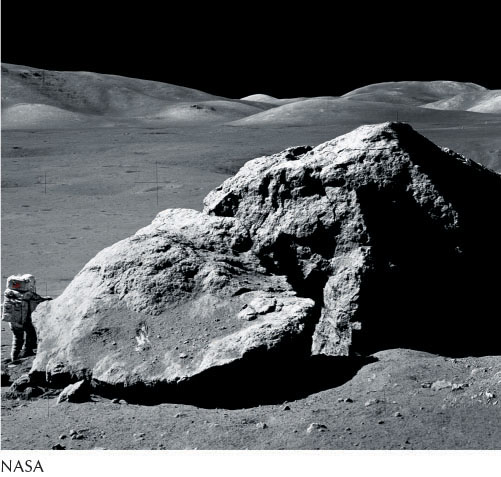
 An Apollo Astronaut on the Moon Apollo 17 astronaut Harrison Schmitt enters the Taurus-Littow Valley on the Moon. The enormous boulder seen here slid down a mountain to the right of this image, fracturing on the way. This final Apollo mission landed in the most rugged terrain of any Apollo flight.
An Apollo Astronaut on the Moon Apollo 17 astronaut Harrison Schmitt enters the Taurus-Littow Valley on the Moon. The enormous boulder seen here slid down a mountain to the right of this image, fracturing on the way. This final Apollo mission landed in the most rugged terrain of any Apollo flight.
Astronauts discovered that the lunar surface is covered with fine powder (Figure 6-22a) and rock fragments (Figure 6-22b). The powdered rock, ranging in thickness from 1 to 20 m, is called the regolith (from the Greek, meaning “blanket of stone”). Regolith formed during 4.5 billion years of relentless micrometeorite bombardment that pulverized the surface rock. We do not refer to this layer as soil, because the term “soil” suggests the presence of decayed biological matter, which is not found on the Moon’s surface.
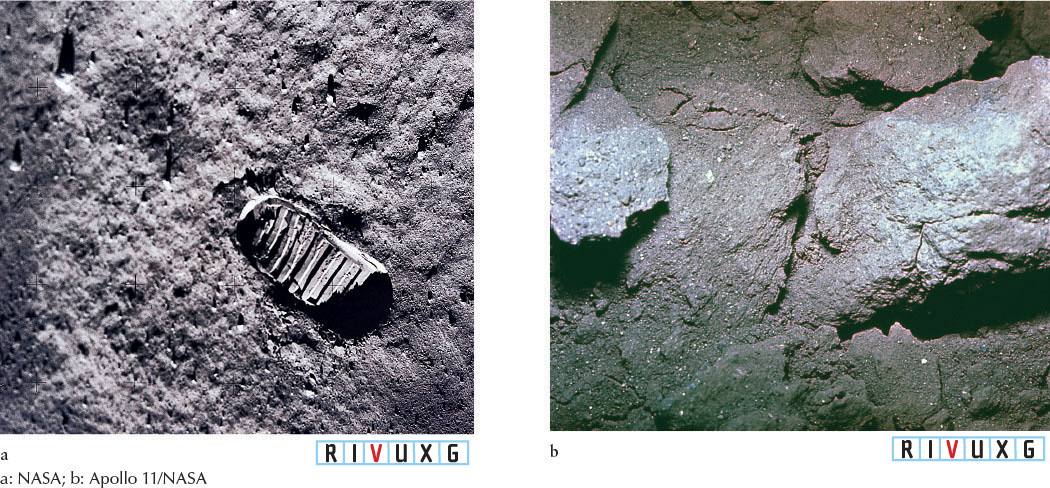
A major goal of the Apollo program was to study the geology of the Moon and help determine its history. The astronauts brought back a total of 382 kg (842 lb) of lunar rocks, which have provided important information about the early history of the Moon. By carefully measuring trace amounts of radioactive elements, geologists determined that lunar rock from the maria is solidified lava dating back only 3.1 to 3.8 billion years. This indicates that the maria developed about a billion years after the Moon formed and that the maria were formed from molten rock, consistent with this material having poured out of the Moon after the Late Heavy Bombardment. These Moon rocks are composed mostly of the same minerals that are found in volcanic rocks in Hawaii and Iceland. The rock of these low-lying lunar plains is called mare basalt (Figure 6-23). About 17% of the Moon’s surface rock is basalt.

176
In contrast to the dark mare basalt, the lunar highlands are covered with anorthosite, dark rock that is somewhat lighter than basalt (Figure 6-24). On Earth, anorthositic rock is found only in very old mountain ranges, such as the Adirondacks in the eastern United States. Compared to the mare basalts, which have more of the heavier elements like iron, manganese, and titanium, anorthosite is rich in calcium and aluminum. Anorthosite is, therefore, less dense than basalt (ignoring the air bubbles in the mare basalts). Typical anorthositic specimens from the highlands are between 4.0 and 4.3 billion years old. These ancient specimens of highland rock probably represent samples of the Moon’s original (pre–Late Heavy Bombardment) crust. Many highland rocks brought back to Earth are impact breccias (Figure 6-25), which are composites of different rock fused together as a result of meteorite impacts.
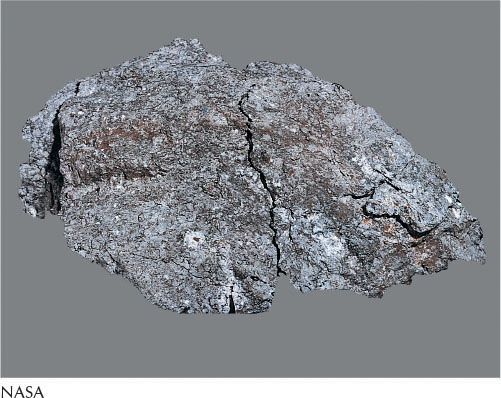

The rough, powdered regolith, composed of intrinsically dark basaltic and anorthositic rock, absorbs most of the light incident on it. The Moon’s albedo is therefore only 0.12, meaning that it scatters only 12% of the light striking it.
Four of the six Apollo missions that landed on the Moon set up scientific packages containing seismic detectors (Figure 6-26). These devices are sensitive to moonquakes, motions of the Moon’s surface analogous to earthquakes. Between 1969 and 1977, they detected more than 12,500 events, including a few quakes strong enough to knock books off shelves (if there had been shelves or books there at the time). Moonquakes occur for any of four reasons: impacts, motion of the lunar surface due to changing tides created by Earth’s gravity, expansion and contraction due to heating and cooling of the Moon’s surface, and other activity inside the Moon that is still under investigation.
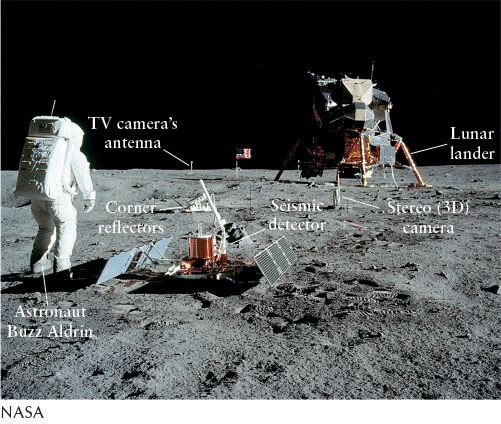
177
With several seismic detectors working simultaneously, geologists were able to deduce information about the Moon’s interior from the timing and strength of the vibrations that were detected. The data suggested that the Moon has a small iron core, possibly a layer of hot rock above it, and a thick layer of solid rock above that, surrounded by the crust. The presence of the iron core, accounting for only 1 to 4% of the Moon’s total mass, was confirmed by data from the Lunar Prospector satellite in 1998. This is a small proportion compared to Earth’s core, which has about 30% of our planet’s total mass.
Like Earth, the Moon’s interior was originally molten. Because the Moon is smaller than Earth, it initially had less heat stored inside. Heat from inside both worlds leaks out through their surfaces, with the smaller Moon cooling faster than Earth. This is why less, if any, of the Moon’s interior is molten today.
Exposed to the cold of space, the Moon’s surface solidified before its hot interior did. As the Moon’s interior cooled and solidified, it became more compact; virtually all substances (except water) shrink when they become solid. Therefore, as the Moon’s interior solidified, gravity pulled its already-solid surface inward. This process could not happen uniformly (think of an apple that is drying on the inside). Therefore, parts of the Moon settled inward faster than other parts. As a result, sharp cliffs called scarps formed where one region of the surface moved down before adjacent regions could (Figure 6-27a). In 2010, astronomers using a camera on the Lunar Reconnaissance Orbiter observed the existence of scarps over much of the Moon’s surface. Calculations indicate that the Moon has shrunk about 100 m as a result of its cooling.
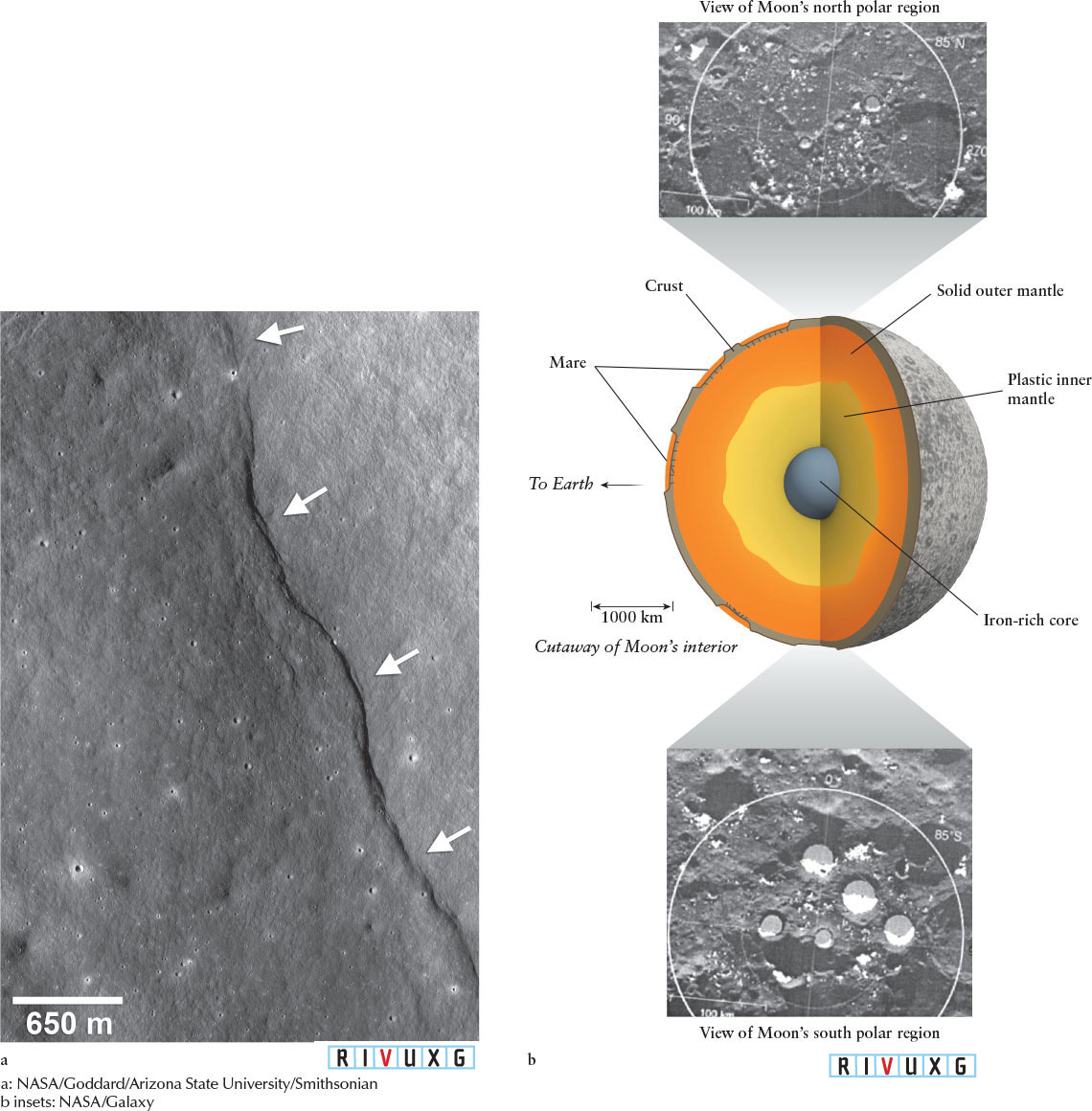
Since spacecraft began orbiting the Moon, scientists have noted that their orbits do not follow the elliptical paths predicted by Kepler’s laws. Every once in a while, usually over a mare, the spacecraft momentarily dip Moonward, as they are pulled by a higher-than-normal concentration of mass. These mass concentrations, or mascons, are local regions of relatively dense rock and metal near the Moon’s surface. The mascons found in maria are believed to be the magma that filled the bottom of the mare after the basins were formed by impacts of very large bodies during the Late Heavy Bombardment. The magma solidified after emerging from inside the Moon. Before the mascons were well understood, a small satellite put in orbit in 1972 by Apollo 16 astronauts came under their influence, and their stronger-than-average gravitational tug caused the satellite to crash into the Moon. The satellite, intended to orbit for years, lasted only 35 days. New mascons continue to be discovered, including seven found by the Lunar Prospector in 1998.
Margin Question 6-6
Question
What type of rock did astronauts bring back from Apollo 11, the first flight to land on the Moon?
In 1994, the lunar-orbiting Clementine spacecraft sent radio signals to the Moon’s surface. These signals scattered off the materials there, and then were received and analyzed on Earth. The results were intriguing, suggesting that frozen water exists in craters near the Moon’s south pole. The presence of ice on the Moon was confirmed by the Lunar Crater Observing and Sensing Satellite (LCROSS), the Indian Chandrayaan-1 lunar orbiter, and the Lunar Prospector orbiter. These craters alone, ranging in size from 2 to 15 km across, contain an estimated 600 million metric tons of water ice. This ice, in polar craters that are never exposed to sunlight, is not in danger of being evaporated (Figure 6-27b). The ice was probably deposited on the Moon during comet and asteroid impacts.
While water ice at the poles, blocked from the Sun’s heat by crater walls, does not surprise astronomers and geologists, the discovery by Chandrayaan-1 in 2010 of water (in the form of OH–, called the hydroxyl radical, and H, hydrogen atoms) in the Moon’s equatorial regolith was unexpected. Even so, compared to Earth, the Moon is bone dry. Assuming that such water-bearing rock is distributed over most of the Moon’s surface, it is estimated that the Moon contains as much water as is in the Great Lakes of North America, which have a volume of about 5400 cubic miles.
178
179
The presence of water ice would greatly simplify human settlement of the Moon, because ice can provide us not only with liquid water, but also with rocket fuel and breathable oxygen. The space shuttle’s primary rocket engine was fueled by liquid oxygen and liquid hydrogen. Separating the Moon’s water into liquid oxygen and liquid hydrogen would create the same fuel. An existing water reservoir would make establishing a lunar colony much less expensive and more feasible than lugging all that water from Earth or dragging a water-rich comet to the Moon.
Astronauts found no traces of life on the Moon. Life as we know it requires liquid water, of which the Moon has none, to form and evolve. The Moon has an atmosphere of helium, argon, sodium, and potassium that is so thin as to be considered an excellent vacuum compared to the density of the air we breathe. An atmosphere is held around a planet or moon by that body’s gravitational force. If the atmospheric gases are too hot (moving too fast) for the gravitational force to hold them, they will leak into space. Our Moon has so little gravitational attraction (about one-sixth of what we feel at Earth’s surface) that it is unable to retain its tenuous atmosphere. The atmosphere is continually being renewed by sunlight striking the Moon, releasing more gas from its rocks. Earth, in contrast, has enough mass to retain such gases as nitrogen, oxygen, carbon dioxide, water, and argon.
The Moon’s slow rotation rate and small iron core suggest that unlike Earth, the Moon should not have a strong magnetic field. Spacecraft orbiting the Moon have confirmed this. However, the Lunar Prospector has discovered local areas where the magnetic field is strong enough to keep the solar wind away from the Moon’s surface. These anomalous regions have yet to be explained.
6-7 The Moon probably formed from debris cast into space when a huge planetesimal struck the young Earth
Before the Apollo program, scientists debated three different theories about the origin of the Moon. The fission theory holds that the Moon was flung out from an extremely rapidly rotating proto-Earth, but no geological evidence supports Earth ever spinning fast enough for this to have occurred. The capture theory posits that the Moon was formed elsewhere in the solar system and then drawn into orbit around Earth by gravitational forces. However, the capture of such a large moon would require it to originally have had a moon of its own, which was flung away from it as those two bodies passed near Earth. That is possible, but very unlikely. Furthermore, because bodies formed in different places have different overall chemical compositions, this theory does not explain the similar geochemistries of the surfaces of the Moon and Earth. The cocreation theory proposes that Earth and the Moon were formed near each other at the same time. As with the fission theory, this theory fails to explain why, compared to Earth, the Moon has less of the denser elements, such as iron, that exist in vast amounts deep within Earth.
A fourth theory, now held to be correct by most astronomers, was first proposed in 1975. It applies the established fact of age-old collisions in the solar system to the formation of the Moon. Called the collision-ejection theory, or large impact theory, it proposes that the newly formed Earth was struck at an angle by a Marssized planetesimal. Some of Earth’s outer layers, along with debris from the impactor, were literally splashed into orbit around the young planet. This orbiting matter became a short-lived ring that eventually condensed to become the Moon, just as planetesimals condensed to form Earth. Evidence from Moon rocks places this event as occurring between 60 and 100 million years after the solar system began forming nearly 4.6 billion years ago. Earth had differentiated (see Section 6-3) before these times, so the material ejected from Earth that helped form the Moon came from Earth’s crust and mantle, but not its iron-rich core. A computer simulation of this cataclysm is shown in Figure 6-28.
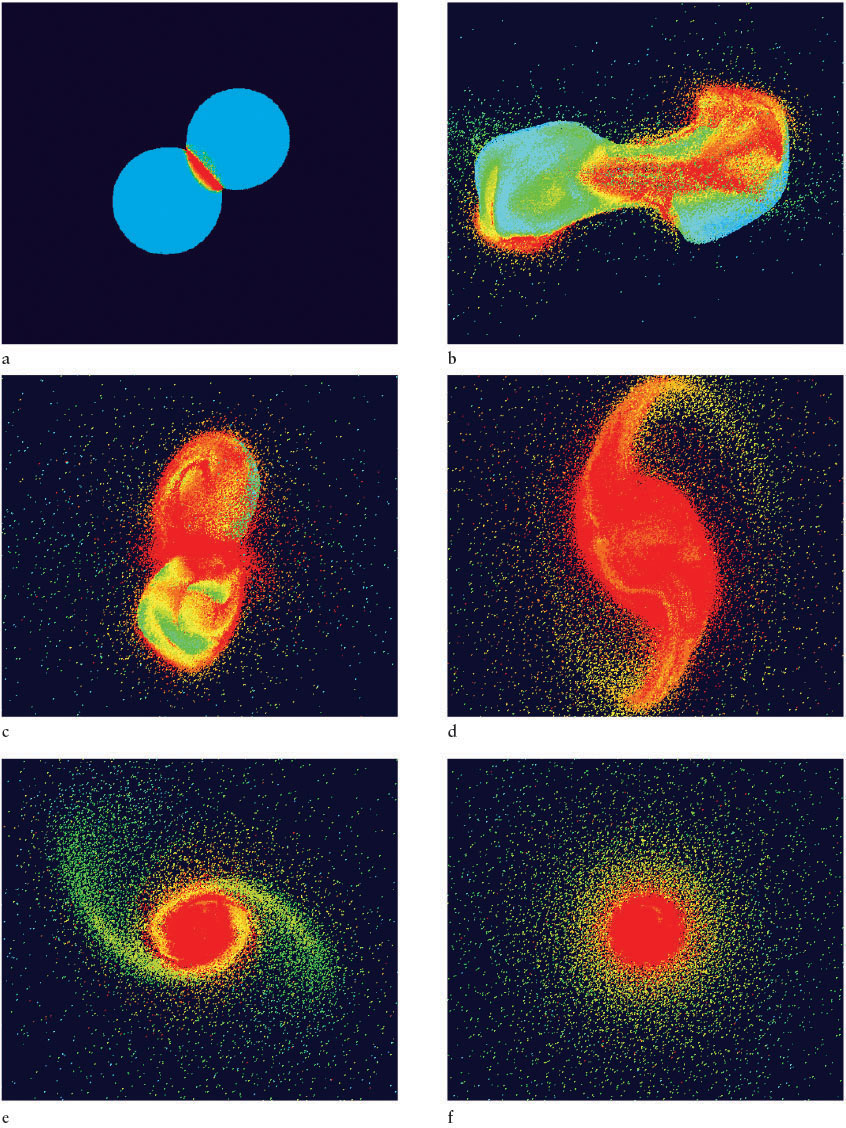
 The Moon’s Creation This computer simulation models the creation of the Moon from material ejected by the impact of a large planetlike body with the young Earth. Successive views (a–f) show the impact, splash, and formation of a ring of debris orbiting the Earth. In this simulation, the impact ejects both mantle and core material, but most of the dense iron falls back onto Earth. The surviving ejected rocky matter forms the ring in frame f. This debris will quickly coalesce into the Moon, initially orbiting some 10 times closer to Earth than it is today.
The Moon’s Creation This computer simulation models the creation of the Moon from material ejected by the impact of a large planetlike body with the young Earth. Successive views (a–f) show the impact, splash, and formation of a ring of debris orbiting the Earth. In this simulation, the impact ejects both mantle and core material, but most of the dense iron falls back onto Earth. The surviving ejected rocky matter forms the ring in frame f. This debris will quickly coalesce into the Moon, initially orbiting some 10 times closer to Earth than it is today.
The collision-ejection theory is consistent with the known facts about the Moon. For example, rock pulverized by the impact would have been depleted of volatile (easily evaporated) elements and water, leaving the Moon relatively low in water (compared to Earth), as we now know to be true. Also, the Moon has little iron-rich matter because that material had sunk deep into Earth before the planetesimal struck. The material from Earth that splashed into orbit and helped form the Moon was mostly the lighter rock floating on Earth’s surface. Furthermore, most of the debris from the collision would orbit near the plane of the ecliptic as long as the orbit of the impacting planetesimal had been near that plane. Also, the impact of an object large enough to create the Moon could have tipped Earth’s axis of rotation, inaugurating the seasons (Figure 6-29). The fact that this theory is both consistent with observations and explains two seemingly separate things (the existence of the Moon and the tilt of Earth) makes it especially appealing to scientists.

The surface of the newborn Moon probably remained molten for millennia, due to heat released during the impact of rock fragments falling onto the young satellite and the decay of short-lived radioactive isotopes inside it. As the Moon gradually cooled, low-density lava floating on its surface began to solidify into the anorthositic crust that exists today in the highlands.
180
By correlating the ages of Moon rocks with the density of craters at the sites where they were collected, geologists have determined how the rate of impacts on the Moon changed over the ages. In summary, the ancient, heavily cratered lunar highlands are evidence of an intense bombardment of asteroids that dominated the Moon’s early history. This barrage began 4.5 billion years ago, when the Moon’s surface first solidified, and ended about 3.8 billion years ago. This period of impacts was punctuated by a severe pounding 4 billion years ago called the Late Heavy Bombardment, which lasted for millions of years. Recall from Chapter 5 that according to the Nice model, this bombardment was caused by the migration of the giant planets.
181
The frequency of impacts gradually tapered off as meteoroids and planetesimals were swept up by the newly formed planets, as discussed in Chapter 5. Recorded among the final scars at the end of this crater-making era are the impacts of more than a dozen objects, each measuring at least 100 km across. As these huge rocks slammed into the young Moon, they blasted gigantic craters. Meanwhile, heat from the decay of long-lived radioactive elements, like uranium and thorium, began to remelt the inside of the Moon. Then, from 3.8 to 3.1 billion years ago, great floods of molten rock from just below the surface (not from the Moon’s core) gushed up from the lunar interior through the weak spots in the crust created by these large impacts. Lava filled the impact basins and created the maria we see today. Because most of the bombardment was over by then, maria have few craters.
The reason that the far side of the Moon has only one significant mare apparently stems from the Moon’s crust on the side facing Earth being thinner than the crust on the far side, as noted in Section 6-5. This difference was created when the Moon was young and molten. At that time, the Moon was much closer to Earth (we will explore this shortly). The Moon’s rapid orbit and the molten rock tides created on it by Earth caused much of the low-density, crustal lava to flow away from Earth to the lunar far side, where it remained when the crust solidified. It was therefore easier for the molten rock inside the Moon to escape through the large craters on the thin crust of our side than through those on the thicker-crusted far side.
Margin Question 6-7
Question
Why are we fortunate on Earth that the Moon is rarely being struck today?
Relatively little large-scale activity has happened on the Moon since those ancient times. Although only a few fresh large craters have been formed, the small-sized debris still plentiful in the solar system continues to create small craters. Back in 1953, an impact was observed that has been connected with the formation of a 1.5-km (0.93-mi) diameter crater. Smaller impacts are observed nearly every year when large groups of rocky space debris, left in orbit from comets as they vaporize, cross the Moon’s path. By and large, however, the astronauts visited a world that has remained largely unchanged for more than 3 billion years. Unlike Earth, which is still quite geologically active, any molten rock inside the Moon has apparently stopped leaking onto that world’s surface. Astronomers hope to learn more about the Moon’s interior when modern seismographs are eventually placed on its surface.
6-8 Tides have played several important roles in the history of Earth and the Moon
Gravitational attraction keeps Earth and the Moon together, while the angular momentum (see An Astronomer’s Toolbox 2-2: Energy and Momentum) given to the Moon when it was formed keeps the Moon from being pulled back onto Earth. Contrary to appearances, the Moon does not orbit Earth. Rather, both bodies are in motion around their common center of mass, called their barycenter (Figure 6-30a), just as a pair of objects tied together and sent spinning across an air table move around a similar common point (Figure 6-30b). This motion is crucial in understanding the cause of the tides, but before explaining them, it is instructive to introduce another tide-related issue, namely that the rate at which the Moon orbits the barycenter and the rate at which it rotates are the same. 
 Except for slight variations as described below, the same surface features on the Moon always face Earth, regardless of what phase the Moon is in (see Figure 1-22). This phenomenon occurs because the Moon is in synchronous rotation around Earth: The Moon rotates on its axis once every 27.3 days, the same length of time it takes the Moon and Earth to orbit their barycenter (Figure 6-31). To see why the Moon must be rotating if it keeps the same side facing us, imagine standing up, holding your arm out in front of you with your palm facing you, and twirling yourself around. You are Earth, while your palm represents the side of the Moon facing Earth. The only way your palm can always face you (be in synchronous rotation) is if your hand (the Moon) rotates at exactly the same rate that it swings (revolves). So the Moon must be rotating.
Except for slight variations as described below, the same surface features on the Moon always face Earth, regardless of what phase the Moon is in (see Figure 1-22). This phenomenon occurs because the Moon is in synchronous rotation around Earth: The Moon rotates on its axis once every 27.3 days, the same length of time it takes the Moon and Earth to orbit their barycenter (Figure 6-31). To see why the Moon must be rotating if it keeps the same side facing us, imagine standing up, holding your arm out in front of you with your palm facing you, and twirling yourself around. You are Earth, while your palm represents the side of the Moon facing Earth. The only way your palm can always face you (be in synchronous rotation) is if your hand (the Moon) rotates at exactly the same rate that it swings (revolves). So the Moon must be rotating.
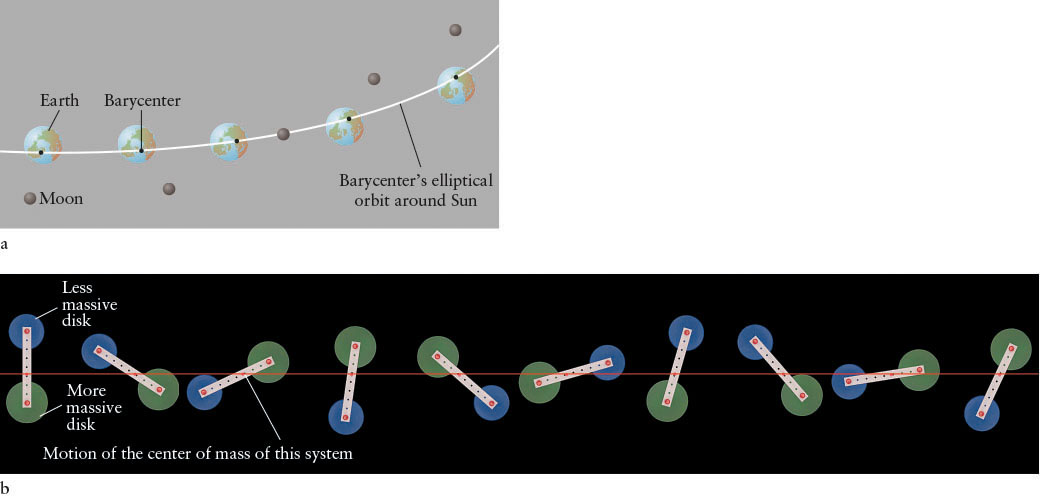
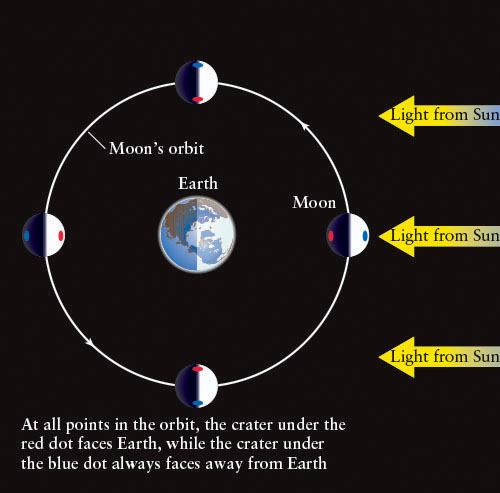
 Synchronous Rotation of the Moon The motion of the Moon around Earth as seen from above Earth’s north polar region (ignoring Earth’s orbit around the Earth–Moon barycenter). For the Moon to keep the same side facing Earth as it orbits our planet, the Moon must rotate on its axis at the same rate that it revolves around Earth.
Synchronous Rotation of the Moon The motion of the Moon around Earth as seen from above Earth’s north polar region (ignoring Earth’s orbit around the Earth–Moon barycenter). For the Moon to keep the same side facing Earth as it orbits our planet, the Moon must rotate on its axis at the same rate that it revolves around Earth.
182
If the Moon’s orbit were perfectly circular, if the Moon’s rotation axis were perpendicular to the plane of its orbit around Earth, if the Moon were orbiting in the plane of the ecliptic, if we were unable to observe the Moon from different places on the Earth’s surface, and if we always saw the Moon at the same distance from Earth throughout the month, then we would see precisely 50% of the Moon’s surface. In fact, none of these statements is true. As a result, we actually see a little beyond the poles and around the sides of the Moon. We can see about 59% of the Moon’s total surface from Earth at different times throughout the year. The changes in what we see of the Moon from Earth due to our motion and the Moon’s motion around the barycenter are called librations.
We have seen the Moon’s complete “far side” only from spacecraft (see Figure 6-20). The far side of the Moon is often, and incorrectly, called its “dark side.” The dark side of the Moon is exactly like the dark side of Earth—it is the side where the Sun is below the horizon. Whenever we view less than a full Moon, we see part of its dark side, while at the same time some sunlight is then striking part of its far side.
The origin of the Moon’s synchronous rotation is in the tidal force from Earth that acted on it shortly after the Moon formed. At the same time, the tidal force from the Moon began creating ocean tides here. To understand both how the Moon came to have synchronous rotation and our present tides, we investigate the forces acting between Earth and the Moon. The discussion in Guided Discovery: Tides focuses on how the Moon creates the tides on Earth. After explaining ocean tides here on Earth, we will explore how Earth once created tides on the Moon that changed the Moon’s original rotation rate to synchronous rotation.
183
 Two-thirds of the tide height on Earth today results from the gravitational tug-of-war between Earth and the Moon as the two bodies orbit their barycenter. The Sun generates most of the remaining third of the tides, with Jupiter and the other planets contributing a tiny fraction.
Two-thirds of the tide height on Earth today results from the gravitational tug-of-war between Earth and the Moon as the two bodies orbit their barycenter. The Sun generates most of the remaining third of the tides, with Jupiter and the other planets contributing a tiny fraction.
 As explained in Guided Discovery: Tides, two high tides always occur on opposite sides of Earth (see Figure GD6-1). When the Sun, the Moon, and Earth are aligned, the Sun and the Moon create pairs of high ocean tides in the same directions, and the resulting combined tides are the highest high tides (and lowest low tides) of the lunar cycle. These spring tides (so-called not because they only occur in the spring—they occur in all seasons—but because the term derives from the German word springen, meaning to “spring up”) occur at every new and full Moon (see Figure GD6-2a). Note that it does not matter whether the Sun and Moon are on the same or opposite sides of Earth when generating the spring tides, because the Sun and the Moon both create high tides on opposite sides of Earth.
As explained in Guided Discovery: Tides, two high tides always occur on opposite sides of Earth (see Figure GD6-1). When the Sun, the Moon, and Earth are aligned, the Sun and the Moon create pairs of high ocean tides in the same directions, and the resulting combined tides are the highest high tides (and lowest low tides) of the lunar cycle. These spring tides (so-called not because they only occur in the spring—they occur in all seasons—but because the term derives from the German word springen, meaning to “spring up”) occur at every new and full Moon (see Figure GD6-2a). Note that it does not matter whether the Sun and Moon are on the same or opposite sides of Earth when generating the spring tides, because the Sun and the Moon both create high tides on opposite sides of Earth.
At first quarter and third quarter, the Sun and the Moon form a right angle as seen from Earth. The gravitational forces they exert compete with each other, so the tidal distortion is the least pronounced. The especially small tidal shifts on these days are called neap tides (Figure GD6-2b).
Finally, we can explain the Moon’s synchronous rotation. When the Moon was young, it was molten and Earth’s gravity created huge tides of molten rock up to 18 m (60 ft) high there. Friction generated by these tides between the liquid rock and the mantle rock below it caused the Moon to speed up or slow down (we do not know which) until one of the high tides became fixed directly between the Moon’s center and the center of Earth. As the surface solidified, it locked onto the interior, causing the entire Moon to rotate at the same rate as its surface. The entire Moon was then in synchronous rotation.
The Moon Was Not in Synchronous Rotation with Earth?
We would, of course, be able to see all parts of the Moon’s surface. More interestingly, the Moon’s rotation would cause land tides to travel along the Moon as it rotated and revolved around the barycenter. These tides would cause the rock of the Moon to rub against itself, creating heat, and causing more of the Moon’s interior to be molten than may be the case today. That molten rock would escape the Moon’s surface in volcanoes and through cracks in its surface, creating a very colorful and dynamic Moon.
6-9 The Moon is moving away from Earth
Margin Question 6-8
Question
Why haven’t the ocean tides on Earth put our planet into synchronous rotation with respect to the Moon?
In 1897, Sir George Darwin (1845–1912), son of the evolutionist Charles Darwin, proposed that the Moon is moving away from Earth. To understand why, read Guided Discovery: Tides and see Figure GD6-2, which shows that the high tide nearest the Moon is actually 10° ahead of the Moon in its orbit around Earth. This offset occurs because friction between the ocean and the ocean floor causes the rapidly spinning Earth to drag the tidal bulge ahead of the line between the center of Earth and the center of the Moon. The gravitational force from the water in the high ocean tide nearest the Moon acts back on the Moon, pulling it ahead in its orbit, giving it energy and thereby forcing it to spiral outward. This effect is similar to what would happen if you tied a ball on a string, let it hang down, and then started spinning yourself around. Your hand would act through the string, giving the ball energy and starting it to spin and move farther and farther away from your body. Contrary to intuition, however, giving the Moon energy to spiral outward does not mean that it is continually moving faster. In fact, the farther it moves away from Earth, the slower it orbits the barycenter.
To test the concept that the Moon is moving away from Earth, Apollo 11, 14, and 15 astronauts placed sets of reflectors on the Moon (see Figure 6-26), similar to the orange and red ones found on cars. These reflectors are specially designed so that light striking them from any direction is reflected back toward its source. Pulses of laser light were fired at the Moon from Earth (Figure 6-32), and the time it took the light to reach the Moon, bounce off a reflector array, and return to Earth was carefully recorded. Knowing the speed of light and the time it takes for the light pulse to make the round trip, astronomers can calculate the distance to the Moon with an error of only a few millimeters. From such measurements made since 1969, astronomers have established that the Moon is currently spiraling away from Earth at a rate of 3.8 cm per year.
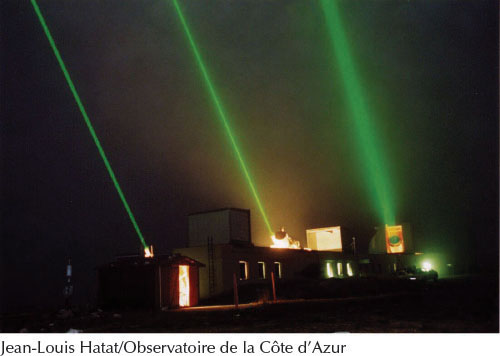
184
GUIDED DISCOVERY: Tides
Tides result from a combination of Earth’s motion around its barycenter with the Moon (or Sun) and the changing strength of the gravitational force from the Moon (or Sun) across Earth. Ignoring Earth’s rotation and focusing on the Moon for the moment, let’s first consider the motion of Earth and the Moon around their barycenter (see Figure 6-30a). The barycenter is located 1720 km (1068 mi) below Earth’s surface on the line between the centers of Earth and the Moon. As a result of its motion around the barycenter, every point on Earth feels an equally strong force away from the Moon, unlike the outward force that you feel while riding on a merry-go-round, which increases with distance from the center. The force away from the Moon is represented at three locations by the force labeled Fout in Figure GD6-1a.
Opposing this force away from the Moon, Earth also has a gravitational attraction to its satellite. Recall from Chapter 2 (An Astronomer’s Toolbox 2-3: Gravitational Force) that the gravitational force exerted by one body on another decreases with distance. Therefore, the Moon’s gravitational attraction on Earth is greatest at the point on Earth’s surface closest to the Moon. This attraction is greater than the force felt at the center of Earth, which in turn is greater than the force felt on the opposite side of Earth from the Moon. The gravitational force in these places is labeled Fgrav in Figure GD6-1a.
Because forces in the same or opposite directions simply add or subtract, respectively, we can subtract the two forces Fout and Fgrav at any point on Earth, due to the presence of the Moon. The resulting net force is labeled Ftide in Figure GD6-1a, and is the tidal force acting at these places. For example, at the point on Earth directly below the Moon, the tidal force is very strong and points toward the Moon. At the center of Earth, the two forces cancel each other completely. At the point on the opposite side of Earth from the Moon, the tidal force is equal in strength to the tidal force directly under the Moon, but is directed away from the Moon.
Consider the point on Earth closest to the Moon. The strength of the tidal force, Ftide, seems to imply that the Moon’s gravitational force lifts the water there to create the high tide. However, the force of gravitation from the Moon is not strong enough to raise that water more than a few centimeters. Rather, the high tide closest to the Moon occurs because ocean waters from nearly halfway around to the opposite side of Earth are pulled Moonward by the gravitational force acting on them. This water slides toward the Moon and fills the ocean directly under it, creating a tidal bulge or high tide. Likewise, the net outward force acting on the opposite side of Earth from the Moon pushes the waters that are just over halfway around from the Moon to the side directly away from it, creating a simultaneous, second high tide of equal magnitude on the opposite side of Earth from the Moon. Where the water has been drained away in this process, low tides occur.

185
Let’s spin Earth back up. As it rotates, the geographic locations of the high and low tides continually change. Figure GD6-1b indicates that high tides occur when the Moon is high in the sky or below our feet, while low tides occur when the Moon is near either horizon. This timing means that there are two cycles of high and low tides at most places on Earth each day. These cycles do not span exactly 24 hours, however, because the Moon is moving along the celestial sphere, changing the time at which high or low tide occurs at any location from day to day. As a result, the time between consecutive high tides is 12 hours, 25 minutes.
Tides are complicated by the fact that the oceans are not uniformly deep, and the shores around continents and islands have a variety of shapes. As a result, in some places the oceans have only a single cycle of tides each day. Some places have tides that change negligibly, while some channels, such as the Bay of Fundy between the United States and Canada (maximum range between high and low tides of 16.3 m) and the Bristol Channel between Wales and England (maximum range of 15 m), have two tides that are each much higher than normal.
Earth’s rotation also has the effect of moving the high tides away from the line between the centers of Earth and the Moon. Earth’s eastward rotation is nearly 30 times faster than the Moon’s eastward revolution around Earth. Therefore, as it rotates, Earth drags the high tides eastward with it. As a result, the high tide that should be directly between the centers of Earth and the Moon is actually 10° ahead of the Moon in its orbit around Earth (Figure GD6-2). This high tide stays at roughly this position because the Moon’s gravitational force pulls the tide westward while it is being dragged eastward by Earth’s rotation; the two effects balance each other out. A similar argument applies to the tide on the opposite side of Earth.
We can repeat this analysis for the Earth–Sun system and get the same qualitative results.
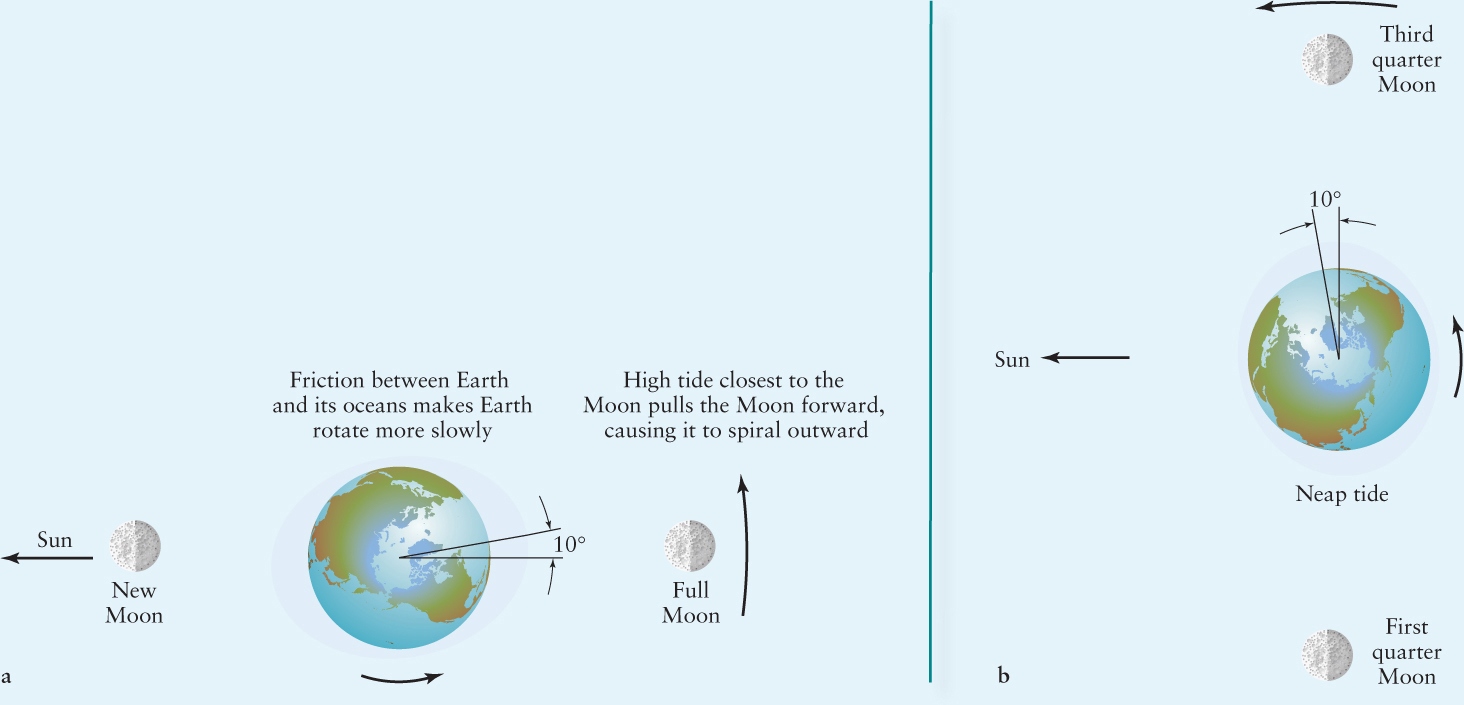
Margin Question 6-9
Question
What effects would the original tides on Earth have had on the geology of our young planet?
186
This means, of course, that the Moon used to be closer to Earth. Although the initial distance of the Moon when it coalesced is not known, its present rate of recession tells us that it was at least half its present distance; more accurate calculations suggest one-tenth. At that latter distance, the tides on Earth were a thousand times higher than they are today.
Where does the Moon get the energy necessary to spiral away from Earth? The answer is from Earth itself. As the tides move westward to try to stay under the Moon, they encounter the eastward-moving landmasses, which disrupt the water’s motion. Because the ocean tides move westward, while the planet rotates eastward, the oceans actually push on the continents opposite to Earth’s direction of rotation. The result is that the tides are slowing Earth’s rotation. The energy lost by Earth as it spins down is gained by the Moon. At present, the day is slowing down by about one-thousandth of a second each century. Based on fossil and other evidence, geologists calculate that when Earth first formed, the day was only between 5 and 10 hours long.
Will the Moon ever leave Earth completely as a result of these dynamics? In fact, it will not. Rather, Earth’s rotation will slow down until it is in synchronous rotation with respect to the Moon. Thereafter, the Moon will remain at a fixed distance over one side of Earth. However, billions of years before that happens, the Sun is going to expand dramatically, make the Earth too hot to support life as we know it, and it may well cause the Earth and Moon to spiral inward and be vaporized.
6-10 Frontiers yet to be discovered
Earth still hold many mysteries. We have yet to understand the different rotation rate of Earth’s core from its surface, as well as the details of the dynamo effect that generates Earth’s magnetic field. We do not know precisely how fast Earth was rotating initially. We also need to better understand the impact of humans on Earth and its atmosphere.
The Moon also inspires many questions and hides many secrets. The six American-manned missions and three Soviet robotic lunar landings have barely scratched the Moon’s surface, bringing back samples from only nine locations. We still know very little about the Moon’s far side. Is the Moon’s interior molten? How massive is the Moon’s iron-rich core? Precisely when did the Moon form and at what distance from Earth? Did lava flows occur over western Oceanus Procellarum only 2 billion years ago, as crater densities there suggest? Is the Moon really geologically dead, or does it just appear dead because our examination of the lunar surface has been so cursory? Such questions can be answered only by sending new and improved science experiments, such as the seismometers mentioned earlier in the chapter, to the Moon.